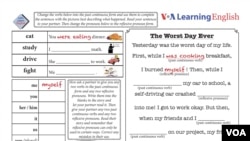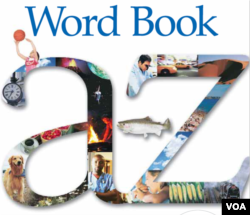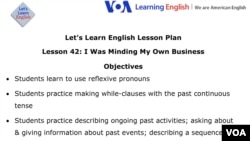Summary
Anna sees a crime and tries to help find the robbers. She hurts her arm. The news reporter wants to know, "How did she hurt herself?"
Anna目击犯罪,试图帮忙抓住抢劫犯,结果胳膊受伤。新闻记者想知道,“她是怎么伤到自己的呢?”
Speaking 口语
In this video, learn how to say the new words. Then learn how to use reflexive pronouns like herself, ourselves, and yourself.
Pronunciation 发音
Use this video to understand how English speakers pronounce the words "did you" quickly and learn to say them as /didjə/.
Conversation 对话
Guy: Hello. I'm Guy Newsman with News Channel XYZ. I’m here in Washington, D.C. at the scene of a crime.
Writing 写作
In this lesson, Anna hurt herself in the vending machine. Did you ever hurt yourself by accident? What were you doing when you hurt yourself? Write to us by email or in the Comments section.
在本课中,Anna使用自动贩售机受伤。你有没有在意外中受伤的经历,你是怎么受伤的?发邮件或评论告诉我们。
Click on the image below to download the Activity Sheet and practice writing and using the past continuous tense and reflexive pronouns.
点击图片下载练习页,练习使用过去进行时和反身代词。
Learning Strategy 学习技巧
Learning Strategies are the thoughts and actions that help make learning easier or more effective.
The learning strategy for this lesson is Read Between the Lines. This expression means to find a hidden meaning in something said or written.
本课的学习技巧是揣摩隐含的意思。
In this lesson, Guy Newsman asks Anna many questions. Anna tells him a long story about the crime. But she doesn't explain how she hurt her arm until the end. Guy reads between the lines each time he guesses about how she hurt her arm.
在本课中,Guy Newsman问了Anna很多问题。Anna长篇累牍给他讲述了犯罪的整个经过,但直到最后才解释了自己的胳膊是怎么受伤的。Guy从头到尾都在从字里行间里揣摩,猜测她受伤的原因。
Do you ever read between the lines to understand what you hear or read in English? Write to us about it in the Comments section or send us an email. Teachers, see the Lesson Plan for more details on teaching this strategy.
你在听读英语时,有没有从字里行间揣摩意思过?发邮件或评论告诉我们。
Quiz 测试
Listen to short videos and test your listening skills with this quiz.
______________________________________________________________
New Words 新词汇
|
Subject Pronouns (Lesson 2) |
Object Pronouns (Lesson 18) |
Possessive Adjectives (Lesson 15) |
Possessive Pronouns (Lesson 37) |
Reflexive Pronouns (Lesson 42) | |
|
1st person |
I |
me |
my |
mine |
myself |
|
2nd person |
you |
you |
your |
yours |
yourself |
|
3rd person (female) |
she |
her |
her |
hers |
herself |
|
3rd person (male) |
he |
him |
his |
his |
himself |
|
3rd person (neutral) |
it |
it |
its |
(not used) |
itself |
|
1st person (plural) |
we |
us |
our |
ours |
ourselves |
|
2nd person (plural) |
you |
you |
your |
yours |
yourselves |
|
3rd person (plural) |
they |
them |
their |
theirs |
themselves |
______________________________________________________________
Free Materials
免费材料
Download the VOA Learning English Word Book for a dictionary of the words we use on this website.
Each Let's Learn English lesson has an Activity Sheet for extra practice on your own or in the classroom. In this lesson, you can use it to practice using the past continuous tense and reflexive pronouns.
For Teachers
教师资源
See the Lesson Plan for this lesson for ideas and more teaching resources. Send us an email if you have comments on this course or questions.
Grammar: Reflexive pronouns; While-clauses; Past Continuous Tense,
Topics: Describing ongoing past activities; Asking about & giving information about past events; Describing a sequence of events; Expressing concern about someone; Reacting to bad news; Expressing sympathy
Learning Strategy: Read Between the Lines
Speaking & Pronunciation: Reflexive pronouns; Pronouncing /didjə/
____________________________________________________________
Now it's your turn. Send us an email or write to us in the Comments section below or on our Facebook page to let us know what you think of this lesson.














